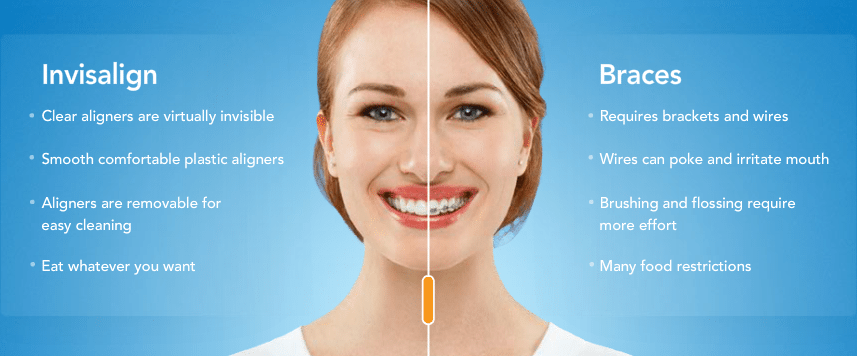Why Invisalign in Los Angeles
Los Angeles Invisalign Questions & Answers
Invisalign in Los Angeles is a convenient and often less expensive orthodontic treatment option that allows doctors to straighten teeth using a series of clear, removable, nearly invisible, plastic appliances called aligners.
The patient meets with Dr. Huang who takes orthodontic records of the patient’s teeth, including impressions, and fills out an Invisalign treatment planning or prescription form and sends all the material to Align Technology. At Align, a computer model of the patient’s teeth is created from the impressions. Align then uses its advanced, 3-D imaging software to generate a graphical representation of the doctor’s treatment plan—almost like an animated movie of the way the patient’s teeth will move from the current position to the final desired position. The doctor reviews and approves the rendering of his treatment plan on a secure portion of Align’s website. Align Technology produces a series of clear, plastic aligners that correspond to the stages of tooth movement in the 3-D movie. The patient wears each stage of aligners for approximately two weeks before switching to the next set in the series. Week by week, the patient’s teeth are straightened millimeter by millimeter under Dr. Huang’s close supervision.
Doctors have successfully used removable appliances for years for very limited treatment. With the application of 3-D computer technology and mass-customization, Invisalign can be used to treat almost anyone who wants straighter teeth. Please ask Dr. Huang if you are a candidate.
Invisalign orthodontic treatments offers a number of convenient advantages and the level of comfort, convenience and confidence that you will not find in any other orthodontic treatment:
- Nearly invisible: You can straighten your teeth without anyone knowing.
- Removable: You can eat and drink what you want.
- Better oral hygiene: You can brush and floss normally to maintain healthy gums and teeth.
- Comfortable: There are no wires, metal or brackets to cause mouth abrasion.
Experienced doctors like Dr. Huang can use Invisalign to treat the vast majority of people who want straighter teeth. According to the Journal of the American Dental Association, two-thirds to three-fourths of American adults (between 136 and 154 million) have some sort of malocclusion (crooked teeth) and could benefit from orthodontic treatment. If you are not a candidate for Invisalign, we will be happy to refer you to a reputable orthodontist in Los Angeles.
Like traditional braces, the length of treatment depends on the complexity of the case. Treatment time typically is about the same as conventional braces – about a year. Dr. Huang will advise you how long it will take for your case before you begin the treatment.
No, Dr. Huang went through extensive Invisalign training. Doctors must attend and complete an Invisalign training seminar to treat patients with Invisalign. Align also provides doctors with many opportunities for continuing education (CE) and advanced Invisalign training and requires that Invalign-trained doctors complete 10 CE hours annually.
Typically, a dental insurance policy that covers traditional braces also covers Invisalign orthodontic treatment to the same extent. In addition, if needed, River Dentistry offers convenient in-office financing.
More than 1 million patients worldwide have entered treatment with Invisalign and that number grows every day. The choice is clear: there are other orthodontics options out there for straightening your teeth, but none offers the level of comfort, convenience and confidence that you’ll find with Invisalign.
Invisalign has FDA clearance as a Class II medical device. In addition to complying with general controls, Class II devices are also subject to special controls including special labeling requirements, mandatory performance standards, and postmarket surveillance. Devices in Class II are held to a higher level of assurance than Class I devices, and are designed to perform as indicated without causing injury or harm to patient or user.





